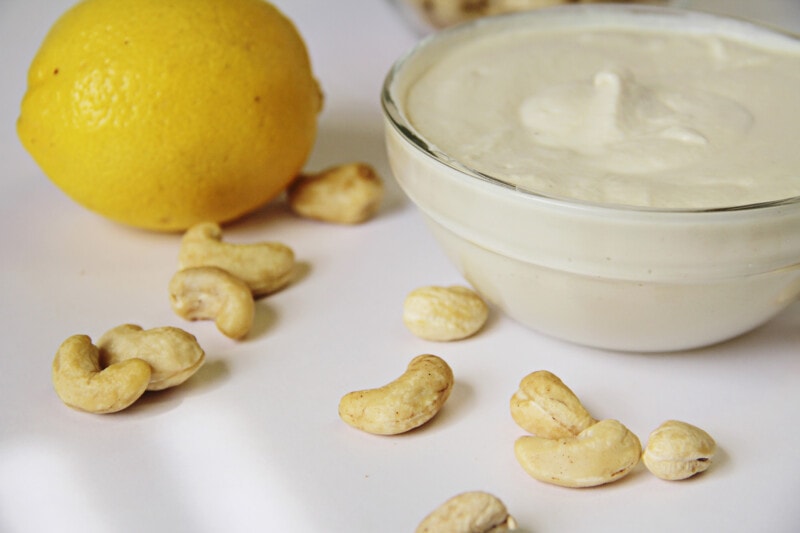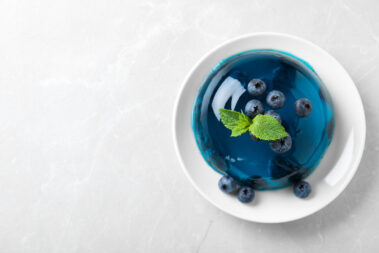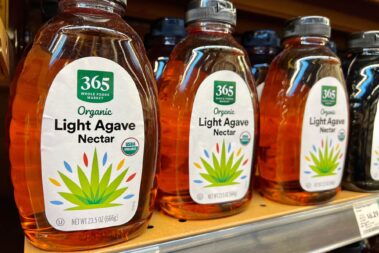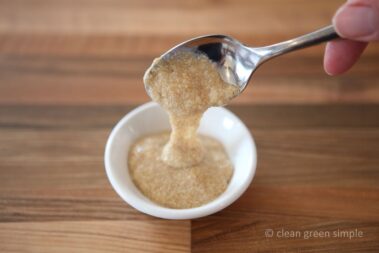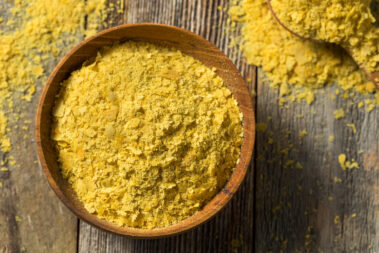When it comes to non-vegan products I miss now that I follow a plant-based diet, cheese, obviously, tops the list. But a surprising item that’s pretty high on that list is sour cream. There is just something so satisfying about putting a dollop of the stuff on a spicy enchilada.
Luckily, it’s possible to make some pretty decent vegan sour cream substitutes at home using just a handful of ingredients.
So, whether you’re making some sour cream-based baked goods, a sour cream sauce, or just need something to put on top of your favorite Tex-Mex dish, you’re in luck. Below, we’ve got five super easy sour cream substitutes plus our favorite recipe for this under-celebrated condiment.
Table of Contents
What Is Sour Cream
It sounds like a silly question, but do you really know what qualifies a dairy product as sour cream?
Like yogurt, sour cream is a fermented dairy product. This means that lactic acid bacteria are introduced to digest some of the sugars in the dairy to create lactic acid. This is what gives sour cream its distinct sour taste.
Where yogurts are made from fermented milk, sour cream is—as the name suggests—made from fermented fresh cream.
This cultured cream makes a delicious topper to many dishes, but it can also be used to create dips and sauces, and to thicken soups. It can even be used to create some pretty amazing desserts.
Best Non-Dairy Substitutes for Sour Cream
In the middle of cooking and suddenly realize your recipe calls for dairy sour cream? Or maybe you’re just missing your favorite burrito topper and looking for a substitute that will suffice. Either way, these great non-dairy sour cream substitutes are here to save the day.
Option 1: Coconut Cream
If you’re after a quick dairy-free sour cream that tastes good enough to top your favorite spicy dish, this coconut cream-based option is the one you want. (Coconut cream, by the way, also makes a great heavy cream substitute!)
Coconut cream, which is the thick, white substance you’ll find stuck to the top of any can of full-fat coconut milk, replicates the texture of dairy cream incredibly well. Add some vinegar to it to emulate the tartness of sour cream and a dash of salt, and you’ve got a convincing plant-based sour cream.
And don’t worry, coconut cream is surprisingly light on coconut flavor. The added lemon juice will easily overpower that little bit of sweetness and leave you with a product that goes great on top of any savory meal.
To make 1 cup of coconut cream sour cream, combine:
- ¾ cup coconut cream
- ¼ tsp apple cider vinegar
- 1 ½ tsp lemon juice
- Pinch of sea salt
Mix well to combine and adjust the amount of the vinegar and fresh lemon juice as needed based on your taste preferences.
This recipe is a great option for topping meals, but it can also be used as a one-to-one ratio in soup and sauce recipes. Because of how coconut fat reacts to heat, you may have to experiment to get it to work right in baked dishes.
Option 2: Soaked Cashews
This substitute takes a little more time to make than the others on this list, but it’s worth it. Not only does it capture the texture of sour cream reasonably well, but it does so while delivering more nutrients than the dairy alternative.
Cashews have a decent amount of protein, lots of iron, and a ton of magnesium. They are a higher-fat nut, but that’s a plus when it comes to replicating sour cream.
Be sure to soak your cashews overnight before making this cashew cream. This will help them blend into a smoother, creamier product. Add a little vinegar, lemon, and salt to the blender to replicate the flavor and you’ll be good to go.
To make 1 1/2 cups of coconut cream sour cream, combine:
- 1 cup soaked raw cashews
- ½ cup water
- 1 tbsp lemon juice
- 1 tsp apple cider vinegar
Throw all the ingredients into your high-powered blender and blend until you get a smooth consistency.
Due to the natural color of cashews, don’t expect the final product to look much like sour cream (maybe if sour cream got a tan…). But this mix will taste pretty close to the real thing.
Use cashew sour cream as a topping or to thicken soups and sauces. This option is not a great choice for baking, however.
Option 3: Silken Tofu
If you’re after a substitute for your favorite baked dessert, silken tofu is your answer. This smooth version of our favorite soy product is perfect for replicating the texture of sour cream. It also has a similar fat content which means it can work as a one-to-one substitute for baked goods.
What makes tofu sour cream better than the real thing is that it has a ton of protein. If you’re a vegan struggling to get enough of this vital macronutrient in your diet, why not make this tofu substitute part of your normal condiment rotation?
To make tofu sour cream substitute, combine:
- 12 ounces of silken tofu
- 1 ½ tbs lemon juice
- ½ tbs apple cider vinegar
- Pinch of salt
- Optional: 1 tsp sugar
Put all ingredients in a high-speed blender and blend until smooth and creamy.
This sour cream alternative works very well in baked goods but also does a pretty good job as a topper or thickener.
Option 4: Soy Yogurt
This substitute is by far the most complicated to make, but it’s well worth it if you have the ingredients and the time.
It has a smoother texture than silken tofu sour cream and can be used in place of regular sour cream in most recipes, including desserts. It also looks convincing in terms of color and thickness, so it’s a good one to use for house guests who don’t know they’re eating vegan.
This recipe does need to chill for a while, so be sure to make it ahead of time.
To make tofu 1 ¼ cups sour cream substitute, combine:
- ½ cup plain soy yogurt
- ½ cup plant-based milk
- ¼ cup soy milk powder
- ½ tbsp cornstarch
- ½ tbsp water
- 1 pinch salt
- ½ tsp lemon juice
Mix the cornstarch and water first until completely dissolved, then set aside. Mix the soy powder with about half the milk then slowly add the rest of the milk while continuing to whisk. Add this mixture to a pan and heat on medium-low.
Add the remaining ingredients, being sure to mix the cornstarch slurry in slowly, then heat until thickened (about 3 minutes).
Pour the mixture into a glass dish, cover it with plastic wrap, and place it in the fridge for at least 1 hour.
This recipe works best as a sour cream substitute in baked goods, soups, and sauces.
Option 5: Store-Bought Vegan Sour Cream
If all this mixing and blending sounds like a little too much for you to deal with, that’s fine too. There are plenty of commercially available vegan sour cream brands out there.
Some of our favorites include:
All of these work fairly well in all situations. The Forager sour cream is especially good as a topper and the Toffuti plain variety is great in baked goods. For baked potatoes, potato salad, and sour cream-forward desserts, we’re all about Kite Hill.
Sour Cream Substitute FAQ
How Long Do Sour Cream Substitutes Last?
In general, you’ll want to use your homemade sour cream substitute within 3 days of making it. But there are a few exceptions to this rule.
Blended cashews and lemon juice (recipe below) can be used for up to 5 days after making when stored in the fridge. And store-bought vegan sour creams are typically good for at least a week after opening. But for these, be sure to reference the label instructions and expiration date.
Do Sour Cream Substitutes Need to be Refrigerated?
Yes, you will need to refrigerate your homemade sour cream substitute. This is imperative not just to keep it from going bad, but for helping it maintain the right consistency. Store-bought vegan sour creams also require refrigeration.
What Is a Vegan Alternative to Sour Cream?
The simplest vegan alternative to sour cream is coconut cream. When mixed with lemon juice, this creates a fairly convincing substitute. However, our favorite sour cream substitute is made with cashews, lemon juice, and apple cider vinegar—see the recipe below.
Best Meals to Pair with Vegan Sour Cream
You can use our vegan substitutes in place of sour cream in any meal you would normally use this condiment in or on.
Here are a few of our favorite recipes to pair these substitutes with:
- Mexican Street Corn Burger – This amazing burger is topped with creamy elote corn kernels, which contain vegan mayonnaise and—you guessed it—vegan sour cream to create an excellent vegan Mexican crema!
- Loaded Vegan Nachos – With tempeh, avocado, onion, jalapenos, olives, corn, and more, these nachos are absolutely loaded with flavor.
- Vegan Taco Salad – This recipe calls for a wonderful homemade dressing with mayo and plain yogurt, but if you want a more traditional flavor, vegan sour cream works great.
- Simple Vegan Curry – Plain greek yogurt is a go-to topper for curry, but we think substituting coconut-cream sour cream elevates the entire dish.
- Vegan Omelette – This omelette is egg-free and loaded with protein thanks to healthy chickpea flour.
- Vegan White Bean Chili – Top this protein-packed veggie and bean stew with a dollop of sour cream to take it to the next level.
- Crispy Cauliflower Tacos – You won’t miss meat with these amazing tacos. Add a dollop of sour cream for a truly unforgettable taco night.
- Baked Accordion Potatoes – These crispy potato appetizers are restaurant amazing and made even better with sour cream for dipping.
- Vegan Sweet Potato Enchiladas – Lentils, sweet potatoes, and spinach come together for an unforgettable combination that redefines what an enchilada should be.
The Best Vegan Sour Cream Recipe
Our preferred vegan sour cream substitute recipe is very similar to number two above, but with a key addition that makes a big difference to the overall flavor. If you’re using your sour cream as a topper rather than an ingredient in the recipe, we definitely recommend using the bonus recipe outlined below.
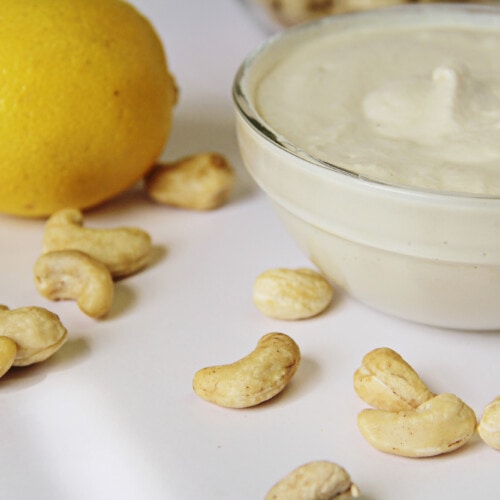
Vegan Sour Cream
Ingredients
- 1 cup raw cashews soaked
- ½ cup water
- 1 tablespoon lemon juice
- 1 teaspoon apple cider vinegar
- ¼ teaspoon sea salt
- ¼ teaspoon Dijon mustard
Instructions
- First, leave your cashews to soak in cold water for at least 4 hours. They should be fully submerged while soaking. Drain the liquid and rinse the nuts before using.
- In a blender or food processor, blend the cashews, water, lemon juice, vinegar, salt, and mustard together. Keep going until the mixture is smooth and creamy. If needed, use a spatula scrape down the sides.
- Taste and adjust the amount of lemon juice or salt if desired.
Notes
- If you have a really powerful food processor, it may be unnecessary to pre-soak the cashews.
- If you are using a large, wide-base blender container, you may need to double this recipe to be able to blend the contents properly.
- Store in the fridge covered, for up to 5 days.

